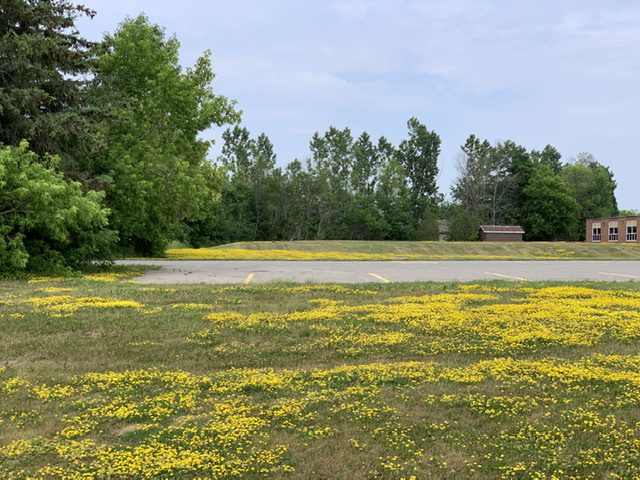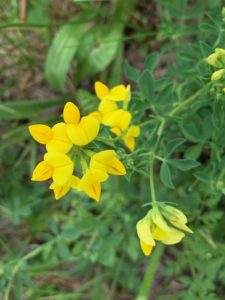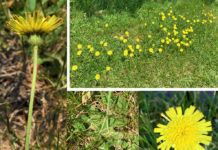

by Dr. Fred Schueler, Fragile Inheritance Natural History
Lotus corniculatus, Bird’s-foot Trefoil (BFT), is the introduced Clover relative that provides borders of brilliant yellow along provincial highways (and along county and municipal roads that aren’t sprayed for Parsnip).
Back in the day, lawns were either green or brown, depending on their water supply, and weren’t spangled with the brilliant patches of buttercup yellow which Bird’s-foot Trefoil now supplies on so many of them. The photo is of the lawn at the Oxford-on-Rideau School, and there are now many lawns around houses, churches, garages, conservation areas, and temples where a significant portion of the area, especially in a dry summer like this one, is yellow with this species.
I first recorded BFT dominating a lawn in June 2007 at the Ministry of Transportation maintenance yard in Kanata. It was until August 2016 at the Prince of Wales Retirement Home along the Rideau River before I next recorded “50% or more coverage of golden lawn,” and then again in August 2017 at the lawn along Hwy 17 at the Deep River Tim Hortons.
Through this decade I presume the BFT was becoming increasingly frequent on lawns, and that I had been finally triggered to start recording its abundance. Since then it has been on many lawns throughout eastern Ontario.
When I queried the Ontario Field Botanists group about increased abundance of this and other low-growing species, no one had any data about the spread of BFT onto lawns, and the response that remembered change was Wasyl Bakowsky’s, who said: “Wow, I never noticed that this didn’t happen 15 years ago. Like gradually losing your long distance vision, for me… until I put on my dad’s glasses, and was like ‘wow, I can see every knothole in that telephone pole.’” When I asked the TAXACOM e-mail list of evolutionary biologists, I got references to papers on other species which had adapted low growth forms in mowed habitats, and the suggestion that such low-growing varieties likely originated in heavily grazed fields.

Bird’s-foot Trefoil is the most widespread species in the genus Lotus, and is native to much of Europe, Asia, and Africa. It is an important agricultural species for pasture and hay production, and has been planted along roadsides to prevent erosion. Infusions of the flowers have been used to calm anxiety, insomnia, and exhaustion. The English name comes from the seedpods looking like the toes of a bird’s foot, and the 5-leaflet leaves are called “t[hre]e-foil” because the two inner leaflets are near the stem and look like stipules. BFT has been introduced to the United States, Iceland, Canada, Japan, Australia, Argentina, Chile, and New Zealand, and is regarded as an invasive species in some areas, especially in prairies where native species are maintained by prescribed burns, which spread BFT by facilitating seed germination on the burned ground (Val Deziel tells me that BFT is not a problem at the Hazel Bird prairie near Rice Lake, south of Peterborough, which she manages, perhaps be- cause the soil is too sandy).
The increased abundance of BFT may have been aided by Ontario’s 2009 ban on the use of recreational herbicides. Other non-grass species are also evolving to live in mowed habitats. White Clover, Trifolium repens, has always been low growing. Dandelions have asexually reproducing ‘microspecies’ which have a great variety of growth forms, and those in frequently mowed lawns spread a flat rosette of leaves well below the danger of the blades. Heal-all, Prunella vulgaris, normally an upright herb a foot tall, can be found on some lawns blooming below mower height.
The “naturalized lawns” movement tries to reduce the dominance of mowed grass, and these low-growing broad-leaved herbs, are moving in on lawns to displace the grass, providing resources to pollinators and colour & diversity to the managers of the lawns.
If anyone has memories of Bird’s-foot Trefoil spreading across their lawn or of any other low-growing species in a lawn, I’d be glad to hear of them at <bckcdb@istar.ca>






